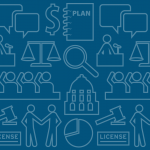Everyone’s health is shaped by conditions in the places where they are born, grow, live, learn, play, work, and age. Research shows that these conditions have a more significant impact on health than clinical factors. These conditions — and the systems and forces that shape them — are the social determinants of health (SDOH). Conditions in our environment include income, wealth, education, employment, workplace climate, housing, food security, community cohesion, neighborhood safety, transportation, health care, and air and water quality.
State, tribal, local, and territorial (STLT) health departments play a critical role in safeguarding public health — both in emergency situations and in pursuing long-term solutions that improve SDOH. Recognizing that STLT health departments vary in their readiness to address SDOH, we have designed a suite of policymaking and community engagement tools to improve their capacity to use law and policy to promote health equity and improve SDOH.
This suite of law and policy resources incorporates feedback from public health practitioners, offering tailored solutions to the challenges that STLT health departments face. For more information on the research and development behind these tools, read our blog post. The collection includes tools to help health departments understand public health authority, confront misinformation, assess their readiness to use the tools of law and policy, and conduct equitable community engagement.
This collection of resources was developed with support from the Centers for Disease Control and Prevention.











